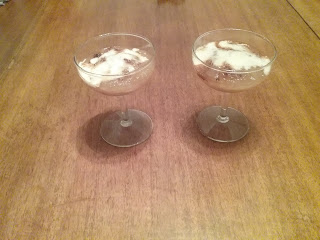The Challenge: Flower Power: Make a dish that's floral, flowery, or flour-y.
The Recipe: I had been intending this challenge for another of those Victorian dainties flavored with rosewater or orange-flower water, but limited grocery excursions have prevented me from restocking on those items (ie, my usual grocery store doesn't have them, and I won't make a longer trip to a specialty store at this time). Therefore, I opted for the 'flour'-y part, with a different Plum Cake (#1008) from The Cook and Housewife's Manual.
The Date/Year and Region: 1837 [6th ed], Edinburgh/London
How Did You Make It: There are three recipes for plum cake in this cookbook: I've previously made the pound cake version (#1007), and decided to try making the other "plain plum cake" (#1008) since I had some left-over cream to use up.
I melted 12 oz of butter in 1 cup of cream, them added 1 1/2 tsp dry active yeast (for the "3 spoonsful good yeast), and let it 'wake up' for about half an hour, keeping it warm in a hot-water bath. I combined 1 lb flour, 1 lb sugar, 1.5 tsp cloves and half a grated nutmeg, beat in 6 large eggs (it calls for 8 eggs, and following the advice I got on the last one, I treated that as 8 medium eggs, and converted to get 6 large). I stirred in the cream-yeast-butter mixture, along with 8 oz of zante currants and 4 oz of candied orange and lemon peel.
The cake was baked in a light-colored-metal springform pan (with 2 layers of parchment paper below, around, and above it) at 325F.
Time to Complete: Prep time 40-45 min, most of that waiting for the yeast; cake baked just over 2.5 hours.
Total Cost: Eggs $1.50, 1/2 lb currants ~$4, candied peel made at home from leftover fruit peels throughout the year, other ingredients on hand.
How Successful Was It?: Very. The cake was just a little dark on the bottom and sides, but not inedible. The receipt made enough batter to fill the 10" pan a bit over half-way up, which made a generous sized cake.
I actually couldn't tell from the texture or flavor that this yeast-risen cake was any different from the other Victorian cakes I've made (generally raised with beaten eggs). It was more substantial than a modern cake, but neither too dense nor too dry. The peel and currants were tasty, and I think the spice proportions worked well (it could do with maybe a touch more nutmeg next time). All in all, I found it a tasty and substantial cake, and it kept well for most of a week under a tea-towel. This is going on the event rotation because it's pleasant and convenient to move/store.
How Accurate Is It?: I used active dry yeast and zante currants for the yeast and currants, as usual, but that's the main departure. I haven't had access to citrons for a few years, so the peel is also my usual mixture of orange and lemon only (I go through enough of it that I boil and save every peel from every lemon and orange that goes through my kitchen).
The decoration of peel fragments and mint leaves is wholly my own fancy. As before, I debated serving it plain versus with icing, and ended up trying to whip the remaining cream using the method from Beeton's #1492, which worked so well for the orange centerpiece. It thickened, but not enough to stand, so I attempted to pour the cream over a slice of the cake, as in a trifle. It wasn't bad, but I think the cake actually stands better on its own.
 |
| A Plain Plum Cake made with yeast |







